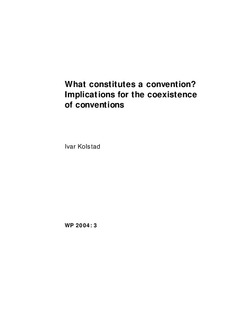What constitutes a convention? Implications for the coexistence of conventions
| dc.contributor.author | Kolstad, Ivar | |
| dc.date.accessioned | 2008-02-21T12:19:07Z | |
| dc.date.accessioned | 2017-03-29T09:12:22Z | |
| dc.date.available | 2008-02-21T12:19:07Z | |
| dc.date.available | 2017-03-29T09:12:22Z | |
| dc.date.issued | 2004 | |
| dc.identifier.isbn | 82-8062-079-6 | |
| dc.identifier.issn | 0804-3639 | |
| dc.identifier.uri | http://hdl.handle.net/11250/2435821 | |
| dc.description.abstract | A model of repeated play of a coordination game, where stage games have a location in social space, and players receive noisy signals of the true location of their games, is reviewed. Sugden (1995) suggests that in such a model, there can be a stationary state of convention coexistence only if interaction is nonuniform across social space. This paper shows that an alternative definition of conventions, which links conventions to actions rather than expectations, permits convention coexistence when interaction is uniform. To assess robustness, the concept of a global mutant is introduced, to which certain states of coexistence are robust. | |
| dc.language.iso | eng | |
| dc.publisher | Chr. Michelsen Institute | |
| dc.relation.ispartofseries | CMI Working paper | |
| dc.relation.ispartofseries | WP 2004: 3 | |
| dc.subject | Conventions | |
| dc.subject | Coordination game | |
| dc.subject | Equilibrium selection | |
| dc.title | What constitutes a convention? Implications for the coexistence of conventions | |
| dc.type | Working paper |
Tilhørende fil(er)
Denne innførselen finnes i følgende samling(er)
-
Bora-import [434]
